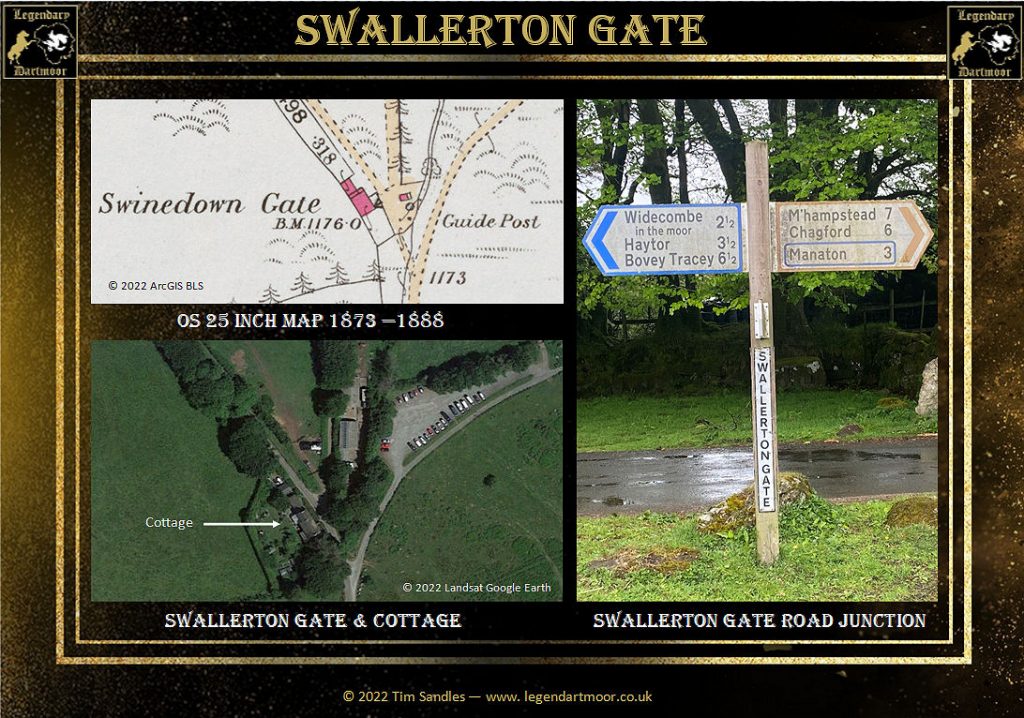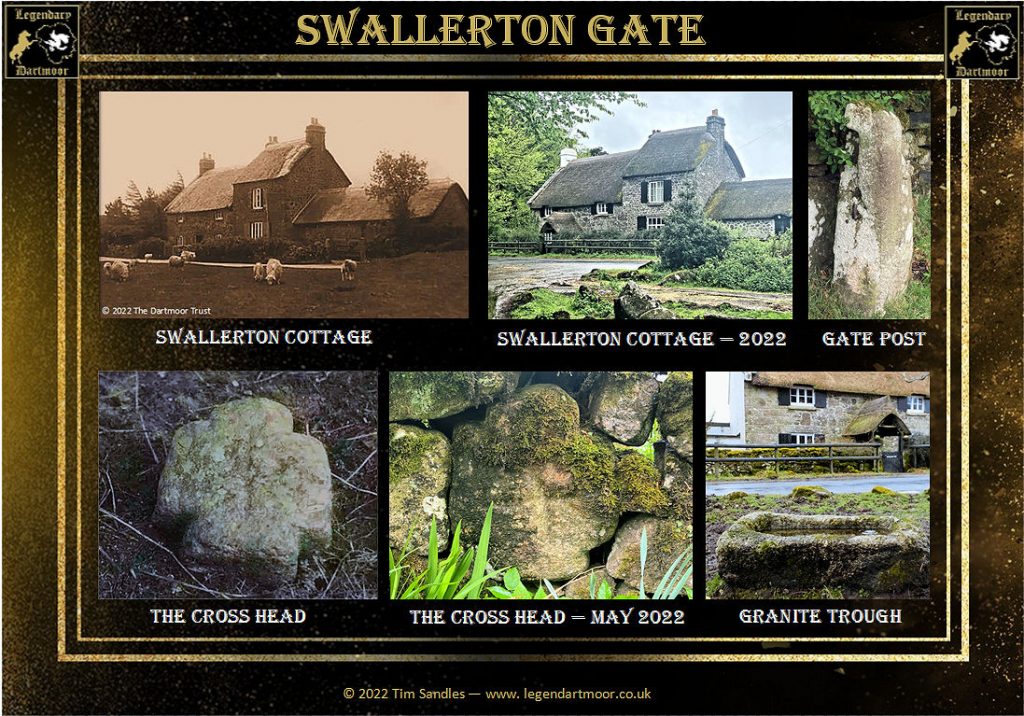 Updated May 2022
Updated May 2022
No doubt numerous folk have sped through Swallerton Gate on their way to Jay’s Grave or Manaton, likewise many people would have parked in the car park near to Swallerton Gate before tripping up to Hound Tor. As you can see from the aerial photograph below the car park is a busy place at times. On the surface there is not a lot to see at Swallerton neither is their much evidence of the associated Dartmoor heritage attached to the location. However, stop a while and have a good look around, you would be surprised what history lies hidden.
It is possible that the name Swallerton stems from the old, corrupted Swine-a-Down (now Swine Down). However, in 1888 The Western Morning News published a ‘to be let for tender’ notice for the estates of William Nosworthy’s following his death. Part of which read , “Also an enclosed down called Swallow Down, or Swine down, of about 75 acres.” So, could it be that Swallerton is a corruption of ‘Swallowdun (the ‘dun’ element referring to a Down)? Thirty-nine years earlier William Nosworthy jnr. Appeared at the Crockernwell Assizes charged with obstructing the road at ‘Swallow Down’ whilst his men were building a wall. During the hearing it was realised that they had summonsed the wrong person who should have been William Nosworthy snr. But junior consented with the case being heard and, in his defence, he stated that the Waywarden had not complained about the obstruction. When asked who the Waywarden was he replied his father – fined fifteen shilling and expenses.
Although marked on the OS map as Swallerton Gate there is little evidence of a gate today but at one time one would have stood there. The only clue to its existence is an old gatepost still with a hinge in it beside Swallerton Cottage. The purpose of the gate was to stop animals straying from one common to the other. It is also at the intersection of three roads, one leading up from Bovey Tracy and Ashburton and going to Moretonhamstead and the other two travelling to Manaton and then on to Moretonhampstead. Tradition has it that at one time a young lad would station himself at the gate and obligingly open and close it for those travelling through, no doubt for a small fee. By the mid-1850s Swallerton Gate was a regular venue for meets of various packs of fox hounds, including Westlake’s hounds, Norton’s hounds and the South Devon hounds to name but a few. With the advent of Dartmoor tours charabancs and coaches for many years used Swallerton Gate as a stop off point for tourists to visit Houndtor. There can be no question that during the past these roads would have seen drovers herding their livestock, journeymen carrying their goods and folk making their way to and from the towns, villages and hamlets. So with all that traffic passing what better place to locate an inn to provide the weary travellers with cider, beer and food. That is exactly what happened and what today is Swallerton Cottage was originally called The Hound Tor Inn but later changed to the Green Dragon Inn.
Brown, p.5. Very little is known about the inn apart from the fact it was built sometime between the 17th and 18th centuries and originally consisted of two buildings, these were later converted into one and an extension was added in the 1920s. The inn closed down sometime in the 1880s, Hemery suggests that another inn, the Newhouse Inn some 4 km away at Blackslade took its custom away.
p.651.
William Crossing provides the following information about the ruined prehistoric kistvaen which is sited near to the cottage – “
A road contractor at that time (1878) lived in the cottage at Swallerton Gate, which is nearby, and the stones of the circle and kist offering themselves as material well suited to his purposes, he had ruthlessly removed them and broken them up.” –
The Stones of Dartmoor, p.40. There are also suggestion s from 1864 that some hut circles once existed near Swallerton Gate which likewise were utilised for road repairs.
In the June of 1930 the cottage was advertised in the Western Morning News as being for sale. It was described as being, “
stone built and thatched, and containing 2 sitting rooms, kitchen scullery, 4 bedrooms, bathroom and W.C., together with gardens, outbuildings, and arable enclosures, the whole extending to 2 acres 2 roods and 39 perches.” At the auction in the July a Mrs Morgan Miles purchased the property for £800. Previous to the purchase the Morgan Miles family would holiday at Swine down Cottage. In later years Swallerton Cottage became more of a guest house although still retaining the word “inn”. In 1933 a travel author wrote that “
There is a new “inn” at Swallerton Gate. No, it is not licenced, but seems to cater for most of the other necessities of life…” The following year the South Devon Hunt held their gymkhana at Hound Tor and noted the following, “Many of the visitors visited the Hound Tor Inn, Swallerton Gate, for tea and were particularly interested in a striking display there of hand-dyed materials with their own hand weaving.” – The Western Morning News, September 3rd, 1934. At this time it was a Miss Messent who was noted as a weaver, spinner and dyer of moorland wool. In 1954 the Hound Tor Inn was again up for auction and as can be read it was quite a going commercial concern by then – “
Hound Tor Inn (Originally known as Swallerton Gate) 2 miles from Manaton. In one of the beauty spots of Dartmoor, with considerable trading value as a Road House or Tea Gardens. 3 reception rooms, 4 bedrooms, garden bed, bath, kitchen, scullery. Central heating; 2 garages, 6 chalets. Good garden and two pasture fields, to a total of 4 acres (one field is licensed for tent camping, and the other will be vacant at Christmas). Included are 70 acres of adjoining moorland known as Swine Down.” –
The Torquay Times, September 10th, 1954. Around this time the famous explorer Thor Heyerdhl often stayed there whilst writing his book ‘The Kon-tiki Expedition’. In 1987 the structure was designated as a Grade II listed building (ID No. 84979). As can be seen from the then and now photos not a lot has changed and the brackets from which the inn sign once hung is still in-situ. In 2013 it was placed on the market for a guide price of £750,000. Today there is the opportunity for a self-catering vacation in the annex of the cottage, more details here –
http://www.swallertongate.co.uk. Just opposite the cottage on a small green sits a relict from Dartmoor’s agricultural past in the form of an old granite trough which undoubtedly at one time belonged to the inn or farm.
A careful examination of the roadside wall of the cottage will reveal an ancient cross head carefully built into it, this is the only fragment of a wayside cross which probably stood nearby. There are many instances of wayside crosses being located at Dartmoor’s road and track intersections. Some will say that early travellers considered that they provided divine protection for those making their ways along remote tracks. There is also a theory that they provided protection from unearthly spirits travelling along ‘ghost paths’ which tended to follow straight roads. Apparently in 1939 it was found lying in a hedge and removed to the garden, Harrison, p.170. In 1987, it was rediscovered and as luck was have it at that precise moment Harry Starkey happened by and pointed out to the owner exactly what he had found. As there was no trace of the cross’s shaft it was decided to build the artefact into the wall where it sits today. Baldwin et. al. p.19. The cross head contains a 14.5 cm high and 15 cm wide incised cross sat within a head measuring 0.46 metres high and 0.37 metres wide, Sandles, p.100. Why the ancient cross was destroyed is a mystery but it could well be it was the victim of the Puritans who were hell bent on destroying any such Popish symbols and ordered their destruction. In some cases the local people could not bring themselves to knock down such sacred symbols and simply hid parts of the crosses.
So should you ever be at Swallerton Gate, pull into the nearby car park, maybe grab a mug of coffee from the refreshment wagon (if it’s there) and have a wander around. If you want to see what a busy bird feeding station looks like have a peek over the wall just past the car park.

Baldwin, J and Others. 1999. The Book of Manaton. Tiverton: Halsgrove Publishing.
Brown, M. 1998. Dartmoor Field Guides – Vol. 48. Plymouth: Dartmoor Press.
Crossing, William, 1987. Stones of Dartmoor. Brixham: Quay Publications
Harrison, B. 2001. Dartmoor’s Stone Crosses. Tiverton: Halsgrove Publishing.
Hemery, E. 1983. High Dartmoor. London: Robert Hale.
Sandles, T. 1997. A Pilgrimage to Dartmoor’s Crosses. Liverton: Forest Publishing.
 Updated May 2022
Updated May 2022
 Legendary Dartmoor The many aspects past and present of Dartmoor
Legendary Dartmoor The many aspects past and present of Dartmoor


